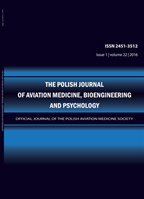2019, Volume 25, Issue 4
HYPOXIA AWARENESS TRAINING AND HYPOXIA SIGNATURE: AN APPRAISAL
AJAY KUMAR1
-------------------------------------------------------------------------------------------------
1Institute of Aerospace Medicine IAF
Autor korenspondencyjny: AJAY KUMAR; Institute of Aerospace Medicine IAF; email: ajay4757giri@gmail.com
Full text
Streszczenie
Abstract: Hypoxia is an omnipresent threat in high altitude flying and considered the number one physiological problem in aviation. The Hypoxia incident is at its minimum in last one century since heavier than air flying began in 1903. This could be possible because of improved and robust oxygen system design over the last century and Hypoxia Awareness Training which an aviator receives throughout his career. Acute exposure to hypoxia leads to manifestation of various Psychomotor and Cognitive signs and symptoms which vary from person to person. However, this constellation of symptoms does not vary in the same individual on repeated exposure to acute hypoxia. This has been termed as Hypoxia Signature which forms the basis of Hypoxia Awareness Training among aircrew. Various studies have concluded that Hypoxia Awareness Training results in early identification of in-flight hypoxia leading to corrective action on time and prevention of catastrophic events in the air. Hypobaric Chamber Training has traditionally been the mainstay for hypoxia awareness training. However, various other modalities like Reduced Oxygen Breathing Device (ROBD) and Combined Altitude and Oxygen Depleted (CADO) paradigm are also being used to impart Hypoxia Awareness Training. In this article, author has reviewed need for Hypoxia Awareness Training (HAT), rationale behind such training along with various methods being employed currently in IAF and world over. The article also discusses objective evidence of effectiveness of HAT and its need to be extended to commercial and general aviation to prevent avoidable loss of lives, property and precious resources due to hypoxia.
Słowa kluczowe
Hypoxia, Hypoxia Signature, Hypoxia Awareness Training, Hypobaric, Normobaric, ROBD
